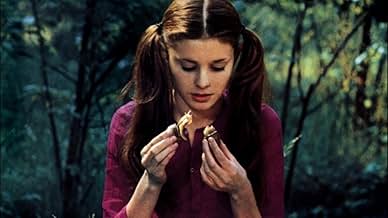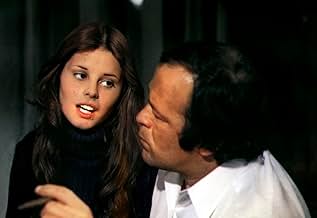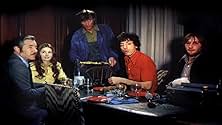Aggiungi una trama nella tua linguaA married couple purchases an abandoned house in the countryside. Soon they witness strange apparitions and events. Their son and their prepubescent daughter are haunted by a poltergeist.A married couple purchases an abandoned house in the countryside. Soon they witness strange apparitions and events. Their son and their prepubescent daughter are haunted by a poltergeist.A married couple purchases an abandoned house in the countryside. Soon they witness strange apparitions and events. Their son and their prepubescent daughter are haunted by a poltergeist.
- Regia
- Sceneggiatura
- Star
- Premi
- 1 vittoria e 1 candidatura in totale
Recensioni in evidenza
You may not have known that Luis Bunuel had a son, Juan Luis, and that he too had a filmmaking career.
Any mystery as regards the source of this ignorance would be instantly dispelled by a viewing of his rare, early '70s haunted house movie, "Expulsion of the Devil" - which also features an appearance by a young Gerard Depardieu.
You see, on the evidence of this film, the younger Bunuel is deservedly obscure. It is possibly the dullest haunted house movie I have ever seen.
The set-up is typical: a family move in to some old house and spooky stuff starts to happen. Well, it's not really that spooky, at least not the way Bunuel Jr. shoots it: two or three times some stuff starts flying around.
I understand that French movies are more concerned with mood than plot. This one has no mood. Juan Luis couldn't direct to save his life.
There are some weird developments later in the movie: a camera crew comes to stay, and apparently, so do some primary school-aged girls. What are they doing there? It might have been explained, or it might not have been. Writing this sentence will be the last energy I ever expend thinking about this movie.
Any mystery as regards the source of this ignorance would be instantly dispelled by a viewing of his rare, early '70s haunted house movie, "Expulsion of the Devil" - which also features an appearance by a young Gerard Depardieu.
You see, on the evidence of this film, the younger Bunuel is deservedly obscure. It is possibly the dullest haunted house movie I have ever seen.
The set-up is typical: a family move in to some old house and spooky stuff starts to happen. Well, it's not really that spooky, at least not the way Bunuel Jr. shoots it: two or three times some stuff starts flying around.
I understand that French movies are more concerned with mood than plot. This one has no mood. Juan Luis couldn't direct to save his life.
There are some weird developments later in the movie: a camera crew comes to stay, and apparently, so do some primary school-aged girls. What are they doing there? It might have been explained, or it might not have been. Writing this sentence will be the last energy I ever expend thinking about this movie.
This is a clunky and rather slow, but mildly interesting French take on the family moves into a haunted house genre. The special effects which largely consist of furniture sliding around are strickly sub-Exorcist, but the film has a few quirky touches which keep the proceedings from being too predictable. Worth a look, if only because French horror films are such a rarity, but this doesn't hold a candle to the similarly themed The Haunting.
A family moves into an old "fixer-upper" mansion in the middle of nowhere. Strange things begin to happen almost immediately, in the form of bizarre "accidents". One night, the teenage daughter, Sophie (Yasmine Dahm) walks in on her amorous parents, causing her to storm off, and windows to shatter for no apparent reason. More incidents occur, more glass breaks, and the mystery deepens. Is the house haunted? Is Sophie possessed? Both? Events get increasingly incredible, including killer kitchen appliances!
Before long, a TV station is interested in filming in the house. The skeptical crew sets up, and the real fun begins!
EXPULSION OF THE DEVIL is a fantastic French horror film that simply must have influenced everything from Stephen King's CARRIE (book and movie), to Kubrick's version of THE SHINING, to POLTERGEIST, to PARANORMAL ACTIVITY, to THE CONJURING 1 and 2, to God knows what else! This is, of course, circular, since this movie was obviously influenced by other hauntings and ghost stories.
NOTE: All would-be makers of so-called "found footage" films should watch this before proceeding.
Special mention must be made of young Ms. Dahm, who never made another movie, though she carried this one with ease!...
Before long, a TV station is interested in filming in the house. The skeptical crew sets up, and the real fun begins!
EXPULSION OF THE DEVIL is a fantastic French horror film that simply must have influenced everything from Stephen King's CARRIE (book and movie), to Kubrick's version of THE SHINING, to POLTERGEIST, to PARANORMAL ACTIVITY, to THE CONJURING 1 and 2, to God knows what else! This is, of course, circular, since this movie was obviously influenced by other hauntings and ghost stories.
NOTE: All would-be makers of so-called "found footage" films should watch this before proceeding.
Special mention must be made of young Ms. Dahm, who never made another movie, though she carried this one with ease!...
I first became aware of this (whose original title translates to the unfathomable AT THE MEETING WITH JOYOUS DEATH!) at a DVD rental store on Santa Monica Boulevard in Hollywood specializing in cult rarities. I remember liking the film at the time but it is possible that I enjoyed it even more on a second viewing (which basically came via the same exceedingly fuzzy print): even so, a proper restoration would really render the movie justice – I have no idea who might own the rights to it, but an outfit like, say, Mondo Macabro certainly missed an opportunity with the release of PARANORMAL ACTIVITY (2007; though its wide-spread release did not occur until 2 years later) and its brand-new follow-up!
The premise, in fact, deals with a family living in a country-house which turns out to be 'alive' – to the point where a TV crew is brought in to 'capture' the paranormal phenomena; though, at the time, this was hardly the ideal choice to pass for one's baptism of fire, let alone the offspring of cinema's greatest Surrealist, he still manages to incorporate a number of touches which must have pleased the old man. Incidentally, having simultaneously watched those distressingly low-key modern takes on the poltergeist theme (which makes their box-office success quite baffling to this viewer!), I could plainly see which film-maker had the bigger balls and the greater imagination – while the PARANORMAL ACTIVITY guys wasted our time with repetitive sequences of trivial kitchen calamities and loud bangings (which only started after much boring exposition!), here we are not only thrown into the mysterious happenings almost instantly but, when the evil forces decide to make their presence felt, what we get is a true debacle (bedroom windows break from the outside, a table flies from the garden though the kitchen window, the refrigerator suddenly becomes violent, even pushing the reasonably burly Renato Salvatori though the window, etc.)!
While in the Hollywood renditions, we only surmise what might be behind the haunting/possession, here we realize that it has to do with the pubescent girl of the house; in fact, when the family moves out to let the TV crew get on with their work, she contrives to get back there (as if compelled to do so) and it is then that the strange occurrences commence once more – beginning with the soundman (a very young Gerard Depardieu) dazedly immersing his hand in a pot of boiling water! In this respect, the film keeps up the 'haunted house' tradition of the era – as in the mansion at the center of THE HAUNTING (1963) also wanting Julie Harris for herself: one might well ask, what the hell for, but here we end on a truly memorable and poetic shot (matching the opening 360-degree pan of the landscape) of the young girl beckoned to the house yet again – with the facade being rapidly enveloped in assorted undergrowth, just as she had pictured it herself at the very start of the film! – the door closing behind her as she enters and the camera moving away.
Having mentioned Depardieu and, again, in clear contrast to today's padding-oriented cinema, the individual character traits of the various technicians are made known to us via a mere handful of dialogue exchanges: geeky Depardieu is the sensitive soul among them, another is an unabashed ladies' man, yet another the hard-working type trying to make ends meet, while the suave presenter – who happens to be a friend of the afflicted family – is at once authoritative but obviously out-of-his-depth amid the situation at hand. Though it is disappointing that lovely leading lady Francoise Fabian (an alumni from Bunuel Snr.'s BELLE DE JOUR [1967]) is off-screen through the entire second half, the film's real protagonist is undoubtedly the daughter – remarkably played by top model Yasmine Dahm (whose only work for the cinema this was). The introduction of an elderly priest (Claude Dauphin) and his brood of adolescent female orphans – who, for years, had spent their summer vacation at the abandoned house – may seem at first as an unwarranted contrivance, but they are eventually revealed to know more than they let on: he not only senses the other girl's connection with the mansion but even carries out an exorcism in private; as for his charges, when Depardieu goes berserk at the end and takes off in Dauphin' van (after beating him to death!), the children who are inside with him suddenly turn on the distraught driver, before heading back!
To get back to what I said at the start of this review, the film includes a few delightfully surreal moments – which have to do with a distortion of reality: the heroine's reflection in a mirror is twice seen not matching her movements (once she is seen dressing while the girl in the mirror takes all her clothes off!); she even visits the family friend, ostensibly to seduce him, but then turns into a monster of some sort – hard to describe exactly due to the inherent print deficiencies, and actually predating a similar scene from Stanley Kubrick's THE SHINING (1980)! – after which his colleagues discover him on his bed covered in mud (by the way, the character's unexpected death scene is equally striking); but the most subliminal and, in retrospect, timely is the technicians' peeping into the keyhole of Dauphin's room to see him sharing his bed with a couple of the girls, only to find the cleric all alone when they burst in on the apparently lewd scene!
I will be following this with another horror-oriented effort from Bunuel Jr., the medieval vampire-themed LEONOR (1975), and his best (and closest to his father's) work, THE WOMAN WITH RED BOOTS (1974) which, though I also came across it in Hollywood, did get released on DVD by Pathfinder.
The premise, in fact, deals with a family living in a country-house which turns out to be 'alive' – to the point where a TV crew is brought in to 'capture' the paranormal phenomena; though, at the time, this was hardly the ideal choice to pass for one's baptism of fire, let alone the offspring of cinema's greatest Surrealist, he still manages to incorporate a number of touches which must have pleased the old man. Incidentally, having simultaneously watched those distressingly low-key modern takes on the poltergeist theme (which makes their box-office success quite baffling to this viewer!), I could plainly see which film-maker had the bigger balls and the greater imagination – while the PARANORMAL ACTIVITY guys wasted our time with repetitive sequences of trivial kitchen calamities and loud bangings (which only started after much boring exposition!), here we are not only thrown into the mysterious happenings almost instantly but, when the evil forces decide to make their presence felt, what we get is a true debacle (bedroom windows break from the outside, a table flies from the garden though the kitchen window, the refrigerator suddenly becomes violent, even pushing the reasonably burly Renato Salvatori though the window, etc.)!
While in the Hollywood renditions, we only surmise what might be behind the haunting/possession, here we realize that it has to do with the pubescent girl of the house; in fact, when the family moves out to let the TV crew get on with their work, she contrives to get back there (as if compelled to do so) and it is then that the strange occurrences commence once more – beginning with the soundman (a very young Gerard Depardieu) dazedly immersing his hand in a pot of boiling water! In this respect, the film keeps up the 'haunted house' tradition of the era – as in the mansion at the center of THE HAUNTING (1963) also wanting Julie Harris for herself: one might well ask, what the hell for, but here we end on a truly memorable and poetic shot (matching the opening 360-degree pan of the landscape) of the young girl beckoned to the house yet again – with the facade being rapidly enveloped in assorted undergrowth, just as she had pictured it herself at the very start of the film! – the door closing behind her as she enters and the camera moving away.
Having mentioned Depardieu and, again, in clear contrast to today's padding-oriented cinema, the individual character traits of the various technicians are made known to us via a mere handful of dialogue exchanges: geeky Depardieu is the sensitive soul among them, another is an unabashed ladies' man, yet another the hard-working type trying to make ends meet, while the suave presenter – who happens to be a friend of the afflicted family – is at once authoritative but obviously out-of-his-depth amid the situation at hand. Though it is disappointing that lovely leading lady Francoise Fabian (an alumni from Bunuel Snr.'s BELLE DE JOUR [1967]) is off-screen through the entire second half, the film's real protagonist is undoubtedly the daughter – remarkably played by top model Yasmine Dahm (whose only work for the cinema this was). The introduction of an elderly priest (Claude Dauphin) and his brood of adolescent female orphans – who, for years, had spent their summer vacation at the abandoned house – may seem at first as an unwarranted contrivance, but they are eventually revealed to know more than they let on: he not only senses the other girl's connection with the mansion but even carries out an exorcism in private; as for his charges, when Depardieu goes berserk at the end and takes off in Dauphin' van (after beating him to death!), the children who are inside with him suddenly turn on the distraught driver, before heading back!
To get back to what I said at the start of this review, the film includes a few delightfully surreal moments – which have to do with a distortion of reality: the heroine's reflection in a mirror is twice seen not matching her movements (once she is seen dressing while the girl in the mirror takes all her clothes off!); she even visits the family friend, ostensibly to seduce him, but then turns into a monster of some sort – hard to describe exactly due to the inherent print deficiencies, and actually predating a similar scene from Stanley Kubrick's THE SHINING (1980)! – after which his colleagues discover him on his bed covered in mud (by the way, the character's unexpected death scene is equally striking); but the most subliminal and, in retrospect, timely is the technicians' peeping into the keyhole of Dauphin's room to see him sharing his bed with a couple of the girls, only to find the cleric all alone when they burst in on the apparently lewd scene!
I will be following this with another horror-oriented effort from Bunuel Jr., the medieval vampire-themed LEONOR (1975), and his best (and closest to his father's) work, THE WOMAN WITH RED BOOTS (1974) which, though I also came across it in Hollywood, did get released on DVD by Pathfinder.
Eerie French horror movie with the vague ending of most French new wave movies. To me the most notable thing is to see a young and thin Gerard Depardieu go nuts. The movie takes awhile to build atmosphere but once the researchers show up, that's when the creepiness begins. The makers of "Poltergeist" had to be influenced by this movie. The main problem of the film is that nothing is ever explained or wrapped up. With my ghost stories I like to know why. As with most haunted house movies, the house is the best character. A mild shocker.
Lo sapevi?
- QuizMimi Young's debut.
- Colonne sonoreConcerto #4
Written par Vieux-Temps
Performed by Arthur Grumiaux, violin
I più visti
Accedi per valutare e creare un elenco di titoli salvati per ottenere consigli personalizzati
- How long is Expulsion of the Devil?Powered by Alexa
Dettagli
- Tempo di esecuzione1 ora 30 minuti
- Mix di suoni
Contribuisci a questa pagina
Suggerisci una modifica o aggiungi i contenuti mancanti

























